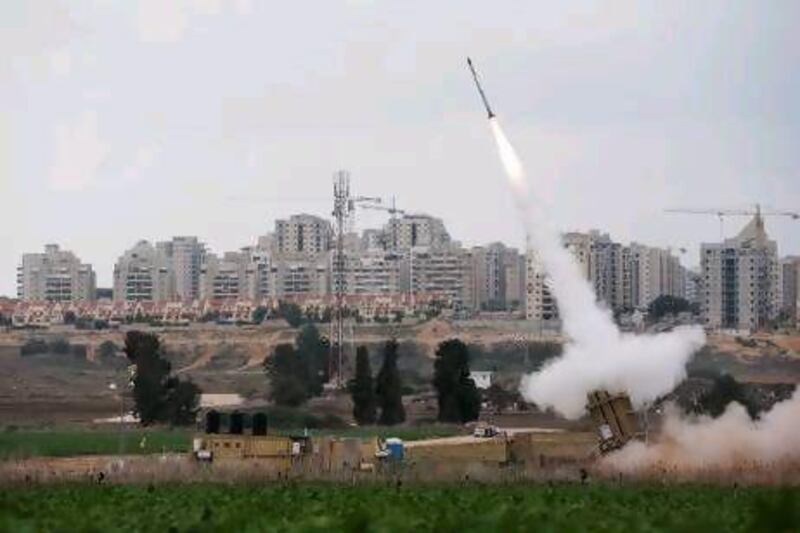TEL AVIV // Four years after Israel's deadly onslaught against Hamas in the Gaza Strip, an expansion in both sides' arsenals has considerably changed the dynamic on the battlefield as Israel's military campaign against the Islamic group enters its seventh day.
Most significantly, Hamas has added long-range, Iranian-made Fajr-5 rockets to its arms stockpiles that for the first time have reached Tel Aviv and Jerusalem.
During Israel's military operation in December 2008 to January 2009, Hamas and other Gaza factions targeted mainly the sparsely populated southern Israeli areas near the Gaza border.
For Israel, the biggest change has been its deployment of the Iron Dome anti-rocket interceptor system in southern Israel and in the Tel Aviv area, which has managed to stop as much as 90 per cent of the more than 300 rockets fired at densely populated areas. Israeli officials view the system as a game changer, claiming it would force Hamas to rethink acquiring more longer-range rockets.
"The main contribution of the Iron Dome, aside from saving Israeli lives, is to put less pressure on Israel from the ongoing rocket attacks and give it more time to prepare for a possible ground operation," said Shaul Yanai, a security expert at Jerusalem's Hebrew University.
Nevertheless, Israel now faces a much stronger Hamas as well as bolstered arsenals by Islamic Jihad and other Gaza factions. Indeed, with Israel believed to have destroyed most of the Iranian-made Fajr-5 rockets in Hamas's stockpiles over the last few days, Islamic Jihad, viewed as Iran's main proxy in Gaza, now remains the only Gaza group to hold several dozens of such projectiles, which it may use to break any ceasefire Israel may clinch with Hamas, according to Mr Yanai.
But Hamas still has more than 10,000 rockets, more than double what it had in 2008, as well as Saudi-funded anti-tank and anti-aircraft missiles as well as more sophisticated machine guns, sniper rifles and explosive materials, experts believe.
Hamas has also constructed in the past few years underground launch sites that are adjacent to civilian facilities such as hospitals, mosques and schools and therefore would be challenging for Israel to destroy without claiming civilian lives, according to experts.
Israeli media this week cited unnamed military officials as saying that Hamas has also reached advanced stages of developing self-made drones and was preparing for test flights.
Israel has attempted to cut Iran's supply of weapons into Gaza. Most recently, in late October, Israel officials hinted that the country was behind the bombing of a munitions factory in Sudan, which Israel believes Iran uses as part of its route to supply arms to Gaza militants.
For Israel, the Iron Dome has been flagged as the main success in curtailing rocket fire from Gaza as it attacks the enclave. Made by the Israeli company, Rafael Advanced Defence Systems, the Iron Dome shoots down rockets and artillery shells with ranges of up to 70 kilometres.
The system, partly funded by the US, Israel's most powerful ally, targets incoming rockets and fires an interceptor missile to destroy them in mid-air.
However, with each missile costing more than US$40,000 (Dh146,928), the system is aimed at shooting down rockets targeting populated areas while ignoring those headed for open areas outside of cities and towns.
But even with their more sophisticated military might, the two sides are now also facing major challenges in their new round of fighting as well as in emerging talks on a possible ceasefirem, and most importantly, the more influential role that Iran plays in Gaza.
Israeli analysts believe that Iran's supply of dozens of Fajr-5 rockets to both Hamas and Islamic Jihad gives it a powerful say in any decisions to launch projectiles at Israel as well as any moves to clinch a long-term ceasefire.
According to Mr Yanai, Islamic Jihad has become Iran's main proxy in Gaza in the past year as Tehran stopped supplying Hamas with weapons after its leaders distanced themselves from Syria, viewed as a key Iranian ally. Mr Yanai said that Hamas is now being backed by Saudi Arabia, Iran's regional rival, and by Qatar.
Iran's ability to control if and when the longer-range rockets are fired by Islamic Jihad makes Tehran a key factor in any possible ceasefire talks between Israel and Hamas, he added. However, such a truce may be hampered by an Iranian demand for Israel to drop any plans to attack its nuclear facilities, which Israel is likely to reject, he said.





